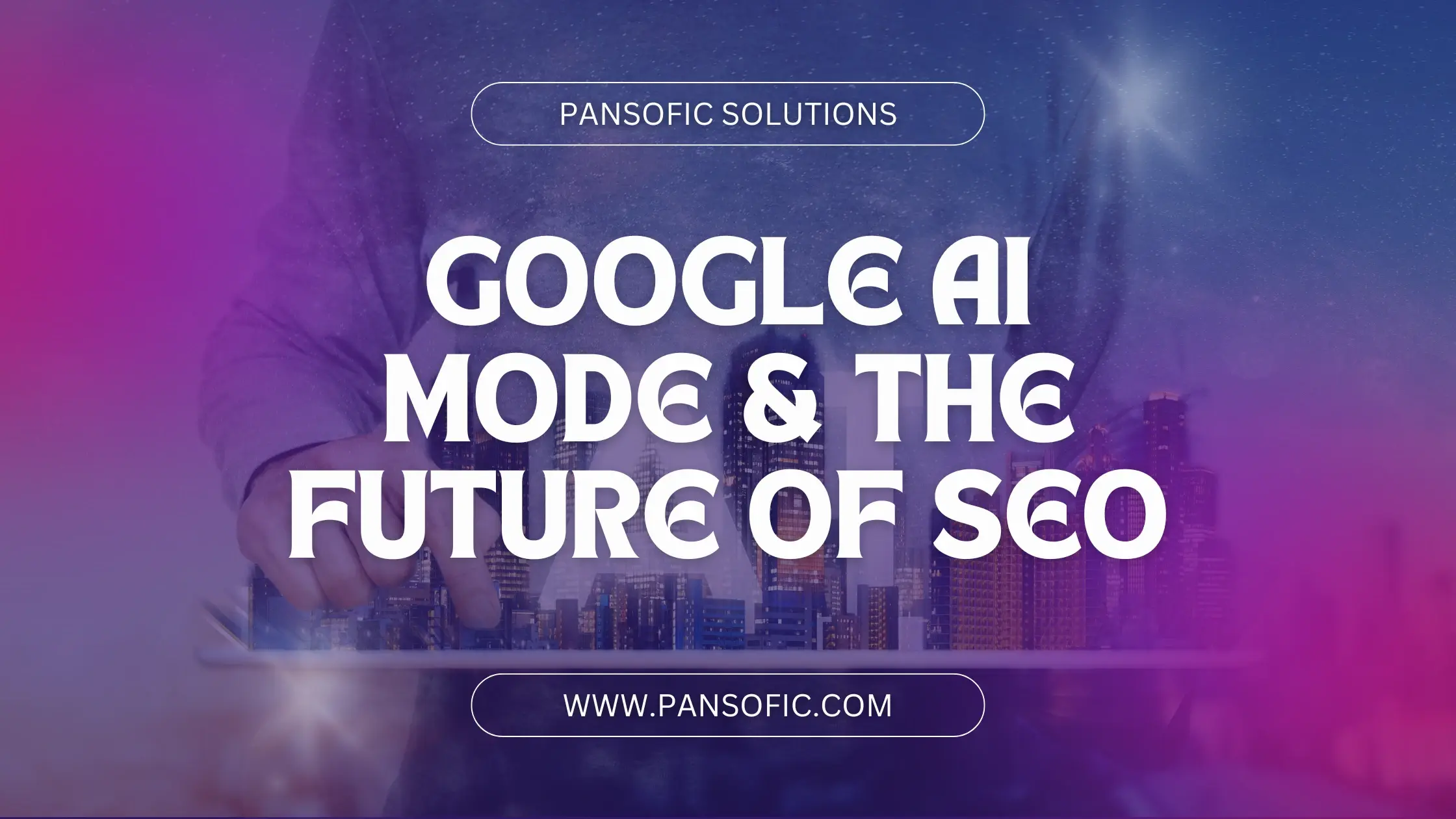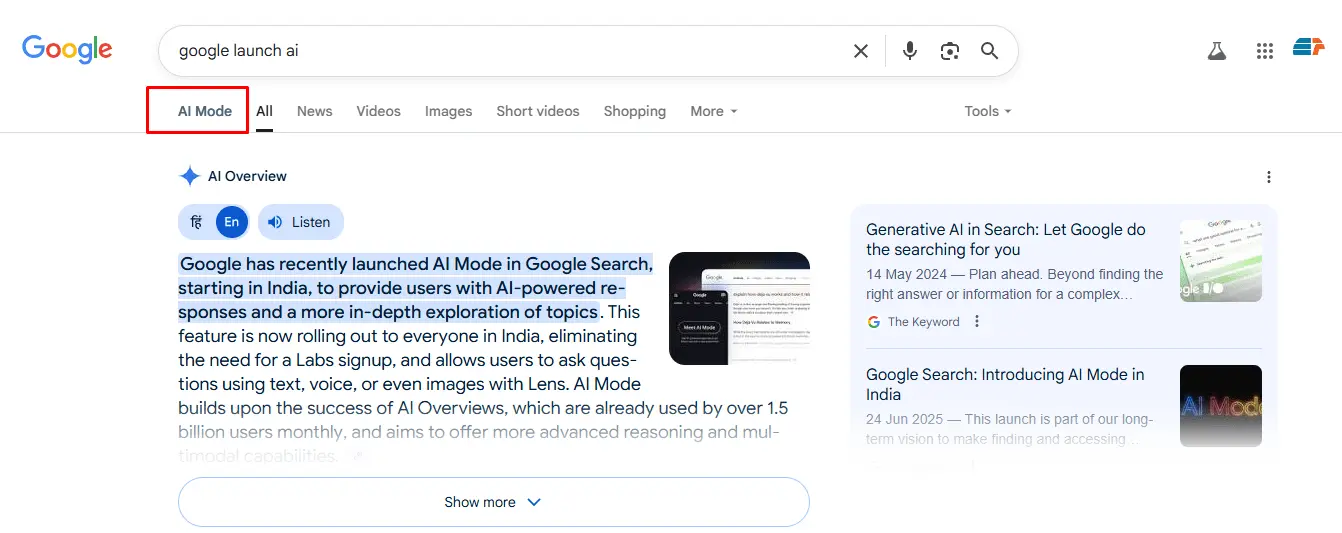Discover how Google AI Mode, launched in India in July 2025, is revolutionizing search and SEO. Learn how generative AI is changing ranking strategies, content creation, and visibility. This Pansofic Solutions blog offers actionable tips, data insights, and optimization strategies to thrive in AI-powered search environments.

Google introduced its AI Mode in India in July 2025 to bring generative search functions to its extensive user base. The AI Mode functions through the Gemini AI model, which transforms the traditional search experience people have with Google Search. Users receive AI-generated summaries, along with conversational follow-up prompts and multimodal search results that integrate text, images, voice, and video, instead of traditional blue link results.

The new feature marks a major change in search engine operations and requires a new approach to SEO because of this fundamental shift. The following blog post explains what Google AI Mode is while showing its effects on SEO and providing strategies for protecting your content approach.
The artificial intelligence technology of Google AI Mode provides users with an innovative search interface that produces quicker and more precise results, which feel more human-like. Through its advanced AI technology, Google provides search results that comprehend user intentions and produce summary-based answers from various sources, while predicting potential question extensions.
Traditionally, SEO focused on optimizing for the top 10 results on the Search Engine Results Page (SERP). With AI Mode, the most valuable placement is now within the AI-generated summary at the top of the results.
Example:
Google might replace ten search result links about eucalyptus honey benefits by generating a concise paragraph that draws from high-ranking pages.
Implication: Ranking in this summary section (often referred to as “Position Zero”) is now more important than ever. However, it’s not just about ranking high—it’s about structuring content so AI can extract it easily.
Actionable Tip:
Use subheadings, lists, FAQs, and structured data (like schema markup) to make your content easier for AI to parse and summarize.
Through AI Mode, the system motivates people to present their questions in ways that match human communication patterns. People now search by using natural phrases that resemble their regular spoken language.
Old Search:
"Buy honey in India online."
New AI-Driven Search:
"Where can I find organic raw honey online with fast shipping in India?"
Implication: Long-tail, natural-sounding queries are replacing short, keyword-stuffed phrases. SEO strategies must evolve to match this behavior.
Actionable Tip:
Begin implementing conversational language in headers and content of your blog, together with meta descriptions. You can discover authentic query formats through Google’s “People Also Ask” and Answer The Public platforms.
Artificial intelligence demonstrates superior abilities at evaluating the quality of content, along with its authority and comprehensiveness. AI summary tools will avoid selecting content that contains repetitive information or excessive keyword placement, or lacks substantial quality.
Example:
When creating content about sunflower honey benefits, you should avoid simple benefit listing.
Include:
Implication: Google prefers content that is helpful, comprehensive, and credible, aligning with its E-E-A-T principles (Experience, Expertise, Authoritativeness, and Trustworthiness).
Google AI Mode can now interpret and present images, videos, and voice-based inputs as part of search results. It’s no longer just about text.
Example:
Blog content about "How to Use Honey for Immunity" would benefit from these enhancements:
Include a brief YouTube video demonstration for viewers
Show an infographic or images that evaluate different honey varieties.

Traditional SEO measurement standards are undergoing an evolution. Your content's visibility in AI systems determines its exposure rather than its position in search results.
You should use this checklist to optimize your content performance in AI-based search environments:
Use schema markup to organize FAQs and articles and recipes, and products on your website. The markup enables AI systems to find particular data sections from your web content.
Create blog posts to provide answers for user inquiries. The headings should use question formats such as “What is the use of digital marketing services?”.
Group your blog content into clusters around a central theme. For example:
Main Topic: Digital Marketing Services
Subtopics:
Make sure your website works well with mobile devices while maintaining fast page speeds and delivering easy navigation. The AI Model from Google also gives preference to content that shows up on sites that perform well.
Adding author bios and citing credible sources together with maintaining current content helps establish trustworthiness to readers.
Google AI Mode does not eliminate SEO but establishes different standards for success. The new SEO environment demands that businesses abandon keyword-based tactics in favor of user-centered approaches. The following aspects require your attention:
Google AI Mode's introduction into India creates a fundamental shift in digital content operations. Businesses, together with bloggers and marketers who want to maintain search engine visibility, need to change their SEO strategies because more users choose AI-enhanced search.
Pansofic Mall, Organicfreshindia, and similar online e-commerce platforms gain access to fresh possibilities because of this change:
Extensive, organized blog content that explains various honey types and their health advantages serves as a foundation for achieving AI summary visibility by implementing schema and structured formatting.
Prioritizing actual human inquiries and discussions allows you to maintain forward momentum during AI-first search times.
The process of SEO (Search Engine Optimization) enhances website rankings on standard search engines such as Google by optimizing keywords and building backlinks, and developing content strategies.
AIO (AI Optimization) represents the process of preparing content to meet the needs of AI-based tools, including chatbots and voice assistants, and generative AI systems such as Google AI Mode and ChatGPT that focus on intent and data structure instead of keywords.
SEO (Answer Engine Optimization) is a subset of SEO that focuses on optimizing content to be featured in AI-generated answers, like those in Google’s AI Mode, SGE (Search Generative Experience), or smart assistants like Alexa. The primary goal of AEO involves securing positions at Position Zero or earning spots within AI-generated snippets. The main difference between SEO and traditional SEO lies in SEO targeting Position Zero or inclusion in AI-driven snippets, whereas SEO aims for traditional SERP rankings.
Generative Engine Optimization (GEO) refers to the method of improving content for AI platforms, which include ChatGPT and Gemini and Claude. The key difference between GEO and AEO or SEO lies in its primary focus which deals with AI tool interpretation and summarization methods for conversational and multimodal applications.
Okay, but it needs to keep up with the times. The old-school SEO tactics like keywords, backlinks, and how your page is organized are still pretty important for getting your site found and indexed. But with AI playing a bigger role and things like AEO (Answer Engine Optimization) and GEO (Google Experience Optimization) becoming key, your content also has to be conversational, well-structured, and understand the context to keep showing up in those AI-generated summaries.
To make sure your content shines in Google's AI ranking system, here's what you should do:
Using structured data, like schema markup, really helps AI systems get a better grasp on your content. It makes it easier for them to pull out specific answers or identify particular types of information. For Answer the Public or similar platforms (AEO), this boosts your chances of getting featured in those AI-generated summaries. And for Generative Outputs (GEO), it allows AI models to reference or even rephrase your content more effectively in the answers they create.
When it comes to SEO, the focus is often on matching keywords to figure out what someone's looking for. But with AI Optimization (AIO), things are different. It uses natural language understanding (NLU) to understand the real meaning and intent behind more complex or conversational search queries. This makes optimizing for user intent much more detailed and accurate.
Not quite right, but close. Although there's some crossover, each one needs its specific adjustments:
The trick is to take the same core content and tweak it slightly for each format.
As for that question, sometimes yes, sometimes no. Users might indeed get their answers directly from AI summaries and not visit your site. However, if your content is used in those AI-generated answers (which is AEO) or if it helps train those AI tools (that's GEO), you can still gain visibility, build brand recognition, and establish authority—even if they don't click through to your page.
Standard SEO tools, you know the usual suspects like Google Search Console or SEMrush, might not give you the full picture when it comes to traffic or visibility generated by AI. If you're focusing on AIO (AI-Optimized) and AEO (AI-Enabled Optimization), you'll want to keep an eye on things like: